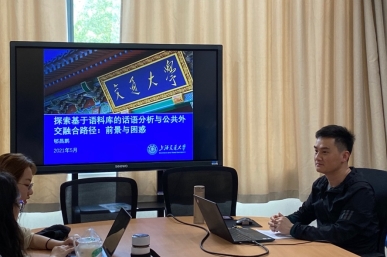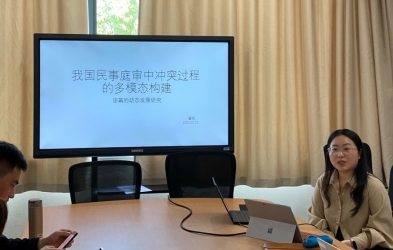The Martin Centre Hosted Appliable Linguistics Seminar 66 (Also known as Seminar on Language Science and System Science 132)
The Martin Centre’s No. 132 Seminar (Linguistic Science and its Appliability) was held offline on May 21 in Meeting Room 225, School of Foreign Languages, SJTU.
Dr Changpeng Huan from Martin Centre for Appliable Linguistics at School of Foreign Languages in Shanghai Jiaotong University reported his recent study titled “Corpsu-based discourse studies and diplomacy studies: Prospects and pitfalls”. Dr Huan shared examples of analysis of China’s image in Australian mainstream media, compared the topic-based approach of media and public opinion analysis with the corpus-based approach of discourse analysis, and pointed out the advantages and disadvantages. Based on current China-Australia bilateral relations, he proposed several research questions, including how the Australian media have constructed the image of China since China became Australia's largest trading partner for the first time in 2009, what kind of discourse strategies have been embodied, and what are the reasons for the Australian perception of China. Using the macroscopic, mesoscopic and microscopic perspectives of discourse historical approach (DHA), Dr Huan examined relations between power relations, key themes and discourse strategies. He also proposed some specific suggestions for public diplomacy policy-making.

Dr. Tao Qu, from the Martin Centre for Appliable Linguistics, School of Foreign Languages, Shanghai Jiao Tong University, gave a report entitled “The multimodal construction of Conflict in Chinese Civil Trials: the dynamic development of text”. Dr. Qu pointed out the necessity to study the dynamic and multimodal nature of conflict discourse, and proposed three research questions: first, how to figure out the main conflicts in civil trials? Second, how do conflicts develop along with time and what are the progression patterns? Third, what role do the various semiotic modes play in the progression of conflicts in civil trials and how do the modes relate to each other? Dr. Qu began by reviewing the various definitions of conflict, summarized the key elements of conflict and stressed that conflict discourse is a dynamic process. Then she explained how to analyze the dynamic and multimodal process by integrating Systemic Functional and Social Semiotic models, including Theme and Information structures, periodicity and identification systems from the former as well as semiotic realization and intersemiotic relations from the latter. After that, she illustrated how to use the framework to solve her research questions by applying it to a specific civil trial case. In the report, Dr. Qu showed how the framework could be used to analyze and help understand the dynamic development of conflicts in civil trials, and also how the Systemic Functional textual models could be expanded to analyze dynamic multimodal texts by integrating with social semiotic theory.

